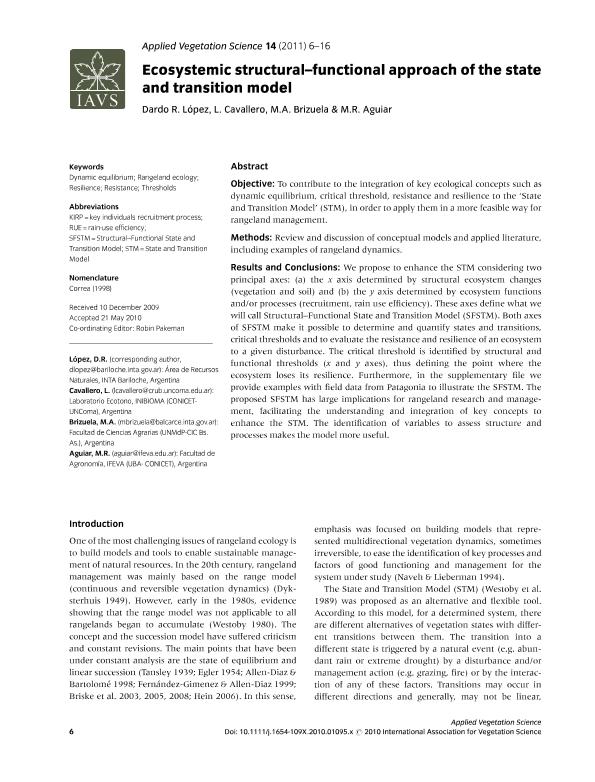Artículo
Ecosystemic structural–functional approach of the state and transition model
Fecha de publicación:
02/2011
Editorial:
Wiley Blackwell Publishing, Inc
Revista:
Applied Vegetation Science
ISSN:
1402-2001
Idioma:
Inglés
Tipo de recurso:
Artículo publicado
Clasificación temática:
Resumen
Objective: To contribute to the integration of key ecological concepts such as dynamic equilibrium, critical threshold, resistance and resilience to the ‘State and Transition Model’ (STM), in order to apply them in a more feasible way for rangeland management. Methods: Review and discussion of conceptual models and applied literature, including examples of rangeland dynamics. Results and Conclusions: We propose to enhance the STM considering two principal axes: (a) the x axis determined by structural ecosystem changes (vegetation and soil) and (b) the y axis determined by ecosystem functions and/or processes (recruitment, rain use efficiency). These axes define what we will call Structural–Functional State and Transition Model (SFSTM). Both axes of SFSTM make it possible to determine and quantify states and transitions, critical thresholds and to evaluate the resistance and resilience of an ecosystem to a given disturbance. The critical threshold is identified by structural and functional thresholds (x and y axes), thus defining the point where the ecosystem loses its resilience. Furthermore, in the supplementary file we provide examples with field data from Patagonia to illustrate the SFSTM. The proposed SFSTM has large implications for rangeland research and management, facilitating the understanding and integration of key concepts to enhance the STM. The identification of variables to assess structure and processes makes the model more useful.
Palabras clave:
DYNAMIC EQUILIBRIUM
,
RANGELAND ECOLOGY
,
RESILIENCE
,
RESISTANCE
,
THRESHOLDS
Archivos asociados
Licencia
Identificadores
Colecciones
Articulos(IFEVA)
Articulos de INST.D/INV.FISIOLOGICAS Y ECO.VINCULADAS A L/AGRIC
Articulos de INST.D/INV.FISIOLOGICAS Y ECO.VINCULADAS A L/AGRIC
Citación
López, Dardo Rubén; Cavallero, Laura; Brizuela, Miguel Angel; Aguiar, Martin Roberto; Ecosystemic structural–functional approach of the state and transition model; Wiley Blackwell Publishing, Inc; Applied Vegetation Science; 14; 1; 2-2011; 6-16
Compartir
Altmétricas




